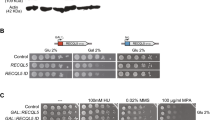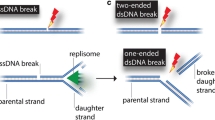Abstract
The influence of dimer removal through excision or photoreactivation on the kinetics of DNA synthesis, sedimentation profiles of DNA molecules and survival of cells was investigated in excision-deficient and excision-proficientEscherichia coli K-12 after a flux of 20 J m−2. In excision-deficient cells photoreactivation did not influence the kinetics of DNA synthesis for a long period and the sedimentation properties of DNA synthesized immediately after photoreactivation were influenced only slightly. However, survival was increased remarkably. In excision-proficient cells where dimers were removed through excision, the kinetics of DNA synthesis increased rapidly, normal-sized DNA molecules were synthesized 60 min after irradiation and survival was substantially higher than in the above-mentioned case. This can hardly be interpreted as a more complete repair of dimers by excision because the persistence of dimers in these cells did not significantly influence either the kinetics of DNA synthesis or normalization of DNA molecules and/or survival of cells. It is concluded that persisting dimers play an important role in excision-deficient but not in excision-proficient cells, that a non-dimer damage to DNA causes inhibition of DNA synthesis after UV and that this damage ia of primary importance for excision-proficient cells which can easily cope with persisting dimers.
Similar content being viewed by others
References
Bridges B. A.: Evidence for a further dark repair process in bacteria.Nature New Biology 240, 52 (1972).
Bridges B. A., Sedgwick S. G.: Effect of photoreactivation on the filling of gaps in deoxyribonucleic acid synthesized after exposure ofEscherichia coli to ultraviolet light.J. Bacterial. 117, 1077 (1974).
Brozmanová J., Slezáriková V., Sedliaková M.: DNA synthesis in pretreated and ultraviolet-irradiated cells ofEscherichia coli B/rHcr + andHcr −.Folia Microbiol. 19, 459 (1974).
Buhl S. N., Setlow R. B., Regan J. D.: DNA repair inPotorous tridactylua.Biophys. J. 14, 791 (1974).
Carrier W. L., Setlow R. B.: Paper strip method for assaying gradient fractions containing radioactive macromolecules.Analyt. Biochem. 43, 427 (1971).
Cleaver J. E., Thomas G. H.: Single strands interruptions in DNA and the effects of caffeine in chinese hamster cells irradiated with ultraviolet light.Biochem. Biophys. Res. Commun. 36, 203 (1969).
Doudney C. O.: Chloramphenicol effects on DNA replication in UV-damaged bacteria.Mutation Research 17, 1 (1973).
Howard-Flanders P., Rupp W. D., Williams B. M., Cole R. S.: DNA replication and recombination after UV irradiation.Cold Spring Harbor Symp. Quant. Biol. 33, 195 (1968).
Iyer V. N., Rupp W. D.: Usefulness of benzoylated naphthoylated DEAE-cellulose to distinguish and fractionate double-stranded regions.Biochim. Biophys. Acta 228, 117 (1971).
Lehmann A. R.: Postreplication repair of DNA in ultraviolet-irradiated mammalian cells.J. Mol. Biol. 66, 319 (1972).
Lehmann A. R., Stevens S.: Postreplication repair of DNA in chick cells: Studies using photoreactivation.Biochim. Biophys. Acta 402, 179 (1975).
McGrath R. A., Williams R. W.: Reconstructionin vivo of irradiatedEscherichia coli deoxyribonucleic acid; the rejoining of broken pieces.Nature 221, 534 (1966).
Meistrich M. L.: Contribution of thymine dimers to the ultraviolet light inactivation of mutants of bacteriophageT 4.J. Mol. Biol. 66, 97 (1972).
Meyn R. E., Humphrey R. M.: Deoxyribonucleic acid synthesis in ultraviolet-light irradiated chinese hamster cells.Biophys. J. 11, 295 (1971).
Michalke H., Bremer H.: RNA synthesis inEscherichia coli after irradiation with ultraviolet light.J. Mol. Biol. 41, 1 (1969).
Pardee A. B., Prestidge L. S.: Ultraviolet-sensitive targets in the enzyme-synthesizing apparatus ofEscherichia coli.J. Bacterial. 93, 1210 (1967).
Pollard E. C., Achey P. M.: Induction of radioresistance inEscherichia coli.Biophys. J. 15, 1141 (1975).
Radman M.: SOS repair hypothesis: Phenomenology of an inducible DNA repair which is accompanied by mutagenesis. In:Molecular Mechanisms for Repair of DNA, part A, Ed. by P. C. Hanawalt and R. B. Setlow, p. 355 (1974).
Rudé J. M., Doudney C. O.: Relation between survival and deoxyribonucleic acid replication in ultraviolet irradiated resistant and sensitive strains ofEscherichia coli B/r.J. Bacteriol. 113, 1161 (1973).
Rupp W. D.: In discussion to the paper: Steps in the repair of DNA: Fact and Fancy. Brookhaven Symp. in Biology, Recovery and Repair Mechanisms in Radiobiology No. 20, p. 1 (1967).
Rupp W. D., Howard-Flanders P.: Discontinuities in the DNA synthesized in an excision-defective strainof Escherichia coli following ultraviolet radiation.J. Mol. Biol. 31, 291 (1968).
Rupp W. D., Wilde Ch. E., Reno D. L., Howard-Flanders P.: Exchanges between DNA strands in ultraviolet-irradiatedEscherichia coli.J. Mol. Biol. 61, 25 (1971).
Rupp W. D., Levine A., Trgovčevič Z.: ICN-UCLA winter conferences on molecular biology, Feb. 24 to March 1, Molecular Mechanisms for the Repair of DNA. Section: Recombination Repair in Bacteria (abstract) 1974)
Sedgwick S. G.: Inducible error-prone repair inEscherichia coli.Proc. Nat. Acad. Sci. 72, 2753 (1975).
Sedliaková M., Mašek F., Brozmanová J., Mašková L., Slezáriková V.: Depression of thymine dimer excision in various excision-proficient strains ofE. coli.Biochim. Biophys. Acta 349, 442 (1974).
Sedliaková M., Brozmanová J., Mašek F.: Persistence of thymine dimers in the replicated DNA ofE. coli B/rHcr +.FEBS Letters 60, 161 (1975).
Sedliaková M., Brozmanová J., Mašek F., Slezáriková V.: Interaction of restoration processon in UV irradiatedE. coli cells.Photochem. Photobiol. 25, 259 (1977).
Sedliaeová M., Prachař J., Piršel M.: Replication of DNA in UV irradiatedEscherichia coli in the absence of amino acids.Folia Microbiol. in press.
Setlov R. B.: In: Regulation of nucleic acid and protein biosynthesis, p. 51–62.V. V. Koningsberger andL. Bosch, ed., Elsevier, Amsterdam, 1967.
Smith K. C.: The roles of genetic recombination and DNA polymerase in the repair of damaged DNA.Photophysiology 6, 209 (1971).
Smith K. C., Meun D. H. C.: Repair of radiation induced damage inE. coli I. Effect of rec mutations on post-replication repair of damage due to UV radiation.J. Mol. Biol. 51, 459 (1970).
Swenson P. A.: Release of the β-galactosidase-synthesizing system from ultraviolet catabolite repression by cyclic 3′-5′-adenosine monophosphate, dark repair, photoreactivation and cold treatment.J. Bacteriol. 109, 391 (1972).
Swemson P. A.: Physiological responses ofE. coli to far-ultraviolet radiation. Photochem.and Photobiol. Rev. K. C. Smith ed., Plenum Press, vol. 1, p. 1 (1976).
Swenson P. A., Schenley R. L.: Evidence for the control of respiration by DNA in ultraviolet-irradiatedE. coli B/r cells.Mutation Res. 9, 443 (1970).
Swenson P. A., Schenley R. L.: Death through respiratory failure of a fraction of ultraviolet-irradiatedEscherichia coli B/r cells.J. Bacteriol. 111, 658 (1972).
Witkin E. M.: Ultraviolet-induced mutation and DNA repair.Annu. Rev. Microbiol. 23, 487 (1969).
Yoney S., Tokunaga F., Nozu K.: Change in the base composition of messenger RNA ofEscherichia coli by ultraviolet irradiation and its recovery.Photochem. Photobiol. 9, 537 (1969).
Author information
Authors and Affiliations
Rights and permissions
About this article
Cite this article
Sedliaková, M., Slezáriková, V. Repair, replication and survival in UV-irradiatedEscherichia coli . Folia Microbiol 22, 81–91 (1977). https://doi.org/10.1007/BF02881632
Received:
Issue Date:
DOI: https://doi.org/10.1007/BF02881632




